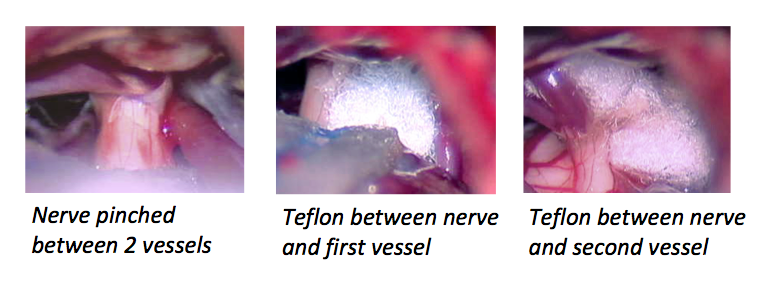UR Medicine / Neurosurgery / Services / Treatments / Microvascular Decompression Surgery
Microvascular Decompression Surgery
For more information, please visit our Comprehensive Facial Pain/Trigeminal Neuralgia Program/Hemifacial Spasm site
What is it?
Microvascular Decompression is a surgical procedure to relieve the symptoms (pain, muscle twitching) caused by compression of a nerve by an artery or vein. It provides the longest duration of relief from trigeminal neuralgia pain, and the lowest rate of permanent numbness of the face after surgery.
What is its goal?
The purpose of Microvascular Decompression is to relieve pressure from a pulsating vessel that is pressing against the trigeminal nerve, causing painful impulses from the face.
How is it done?
The procedure is done under general anesthesia. Hair behind the ear is shaved and a small part of your skull is removed. The nerve is identified and pieces of Teflon are placed between the nerve and the offending blood vessel(s). The small area of bone removal is then covered with a thin metal mesh.

How long will I stay in the hospital?
Most patients are discharged after 2 nights.
Going home
Approximately 95% of patients will have rapid relief from pain. You will need to continue all preoperative pain medication. These will be slowly decreased after one month by the physician who started them. Staples/sutures are removed 10 to 14 days after surgery. Most patients may also experience muffled hearing on the side of surgery, facial numbness, fatigue from anesthesia, nausea/vomiting in the hospital (meds will be given) which usually improves over time. You may not drive or go back to work for about one month. You cannot wear wigs, use hair dye or other harsh products for 6 months. These will interfere in long term healing and may cause infection which could require further surgery.
What are the risks?
Microvascular decompression is an invasive procedure, and while safe in expert hands, does have potential rare/infrequent risks, including:
- Infection
- Hearing loss, facial numbness, and/or facial weakness (usually temporary, rarely permanent)
- Spinal fluid leak
- Difficulty with speech or swallowing
- Stroke or hemorrhage (very rare)
What is needed before Microvascular Decompression surgery?
- Special MRI (“Trigeminal neuralgia protocol MRI”)
- Special CT scan (“Brainlab CT”)
- Hearing test (audiogram)
- Blood work and possibly a EKG
- Baseline brain wave monitoring (used to monitor nerves at surgery)
- Preoperative physical and evaluation
- Updated list of medications to preoperative evaluation